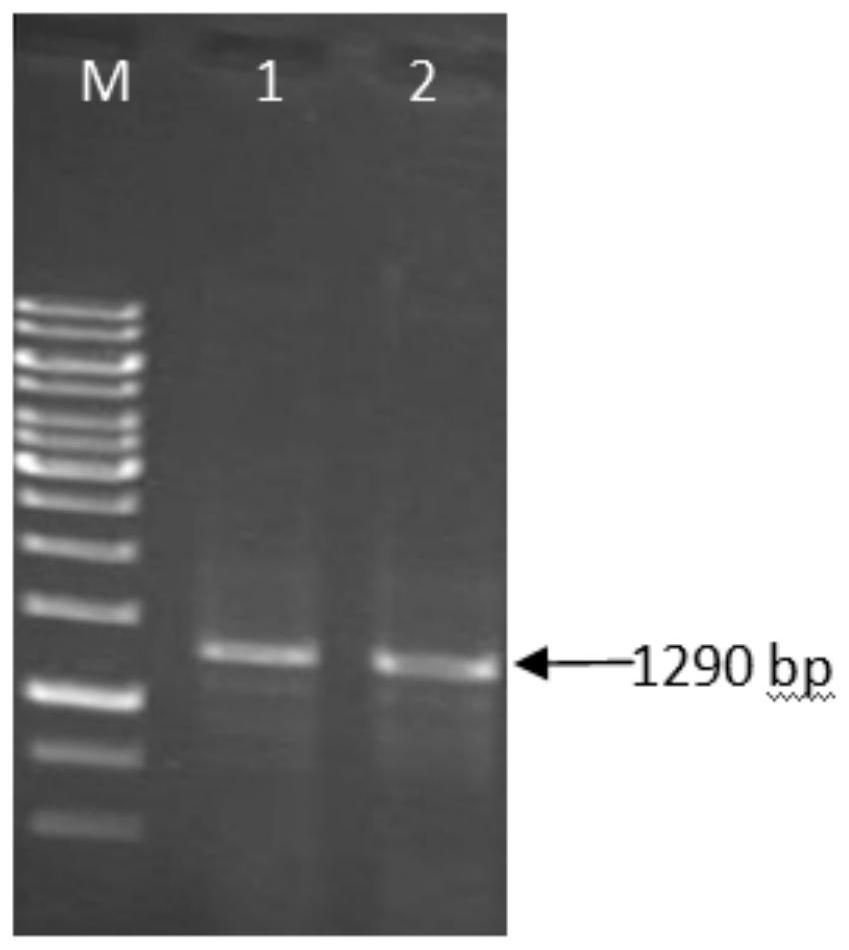Pseudomonas putida enolase gene cloning method and application
A technology of pseudomonas enolase and cloning method, applied in the field of genetic engineering, can solve the problems of reducing the production cost of PHA, weak tolerance and the like, and achieve the effects of improving tolerance and low price
- Summary
- Abstract
- Description
- Claims
- Application Information
AI Technical Summary
Problems solved by technology
Method used
Image
Examples
Embodiment 1
[0033] Embodiment 1 A kind of Pseudomonas putida enolase gene cloning method
[0034] Present embodiment parent adopts putida Pseudomonas (P.putida KT2442)
[0035] 1. Extract the total DNA of Pseudomonas putida
[0036] From the -80°C refrigerator, use an inoculation loop to dip the Pseudomonas putida bacteria solution on the medium for overnight culture, pick a single colony on the plate and culture it overnight in 10ml culture solution, and mix with 30% glycerol for 1 : 1 volume is mixed in a sterile 1.5ml cryopreservation tube, the molecular cloning method is used to extract the total DNA genome of Pseudomonas putida and a small amount of plasmid extraction.
[0037] 2. Cloning of enolase gene
[0038] The extracted total DNA was used as a template, and the upstream primer P1 and downstream primer P2 were used as specific primers to amplify the target fragment by PCR; the sequences of P1 and P2 are:
[0039] P1: GAT AAGCTT GTATGGCAAAAATCGTCG
[0040] P2: CAT CTCGAG ...
Embodiment 2
[0068] Example 2 IPTG concentration condition optimization
[0069] Spread the recombinant bacterial liquid containing the recombinant plasmid pET28a-eno on the LB plate containing Kan resistance, and screen for positive clones. Pick a single colony and inoculate it in the culture medium containing Kan and cultivate it overnight; transfer it to fresh LB medium according to the inoculation amount of 1-3%, and cultivate it to OD at 37°C 600 About 0.5, add IPTG with final concentrations of 1 mM, 0.5 mM, and 0.2 mM respectively, and incubate at 30°C for 4 hours; collect the bacteria at 8000 rpm, and wash once with water.
[0070] After the expression of the target protein was induced, each 200ml of initial culture was resuspended with 4ml of binding buffer, ultrasonically disrupted, 400W, 5s work, 5s interval, repeated 20 times; after the bacteria were broken, they were centrifuged at 10,000rpm for 20min to remove cell debris, and collected For the supernatant and the precipitate...
Embodiment 3
[0072] Embodiment 3 cultivation temperature optimization
[0073] Spread the recombinant bacterial liquid containing the recombinant plasmid pET28a-eno on the LB plate containing Kan resistance, and screen for positive clones. Pick a single colony and inoculate it in the culture medium containing Kan and cultivate it overnight; transfer it to fresh LB medium according to the inoculation amount of 1-3%, and cultivate it to OD at 37°C 600 About 0.5, add IPTG with a final concentration of 1mM, incubate at 20°C, 25°C, and 30°C for 4h; collect the bacteria at 8000rpm, and wash once with water.
[0074] After the expression of the target protein was induced, each 200ml of initial culture was resuspended with 4ml of binding buffer, ultrasonically disrupted, 400W, 5s work, 5s interval, repeated 20 times; after the bacteria were broken, they were centrifuged at 10,000rpm for 20min to remove cell debris, and collected For the supernatant and the precipitate, 40 μl of the supernatant an...
PUM
 Login to View More
Login to View More Abstract
Description
Claims
Application Information
 Login to View More
Login to View More - R&D
- Intellectual Property
- Life Sciences
- Materials
- Tech Scout
- Unparalleled Data Quality
- Higher Quality Content
- 60% Fewer Hallucinations
Browse by: Latest US Patents, China's latest patents, Technical Efficacy Thesaurus, Application Domain, Technology Topic, Popular Technical Reports.
© 2025 PatSnap. All rights reserved.Legal|Privacy policy|Modern Slavery Act Transparency Statement|Sitemap|About US| Contact US: help@patsnap.com



